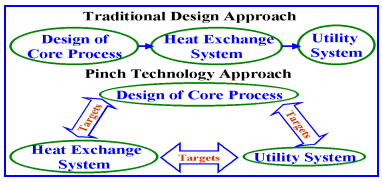Chemical and Process Engineering Resources
Development of the Pinch Technology Approach
When the process involves single hot and cold streams (as in above example) it is easy to design an optimum heat recovery exchanger network intuitively by heuristic methods. In any industrial set-up the number of streams is so large that the traditional design approach has been found to be limiting in the design of a good network. With the development of pinch technology in the late 1980’s, not only optimal network design was made possible, but also considerable process improvements could be discovered. Both the traditional and pinch approaches are depicted in Figure 2.
 |
| Figure 2: Graphic Representation of Traditional and Pinch Design Approaches |
First, the core of the process is designed with fixed flow rates and temperatures yielding the heat and mass balance for the process. Then the design of a heat recovery system is completed. Next, the remaining duties are satisfied by the use of the utility system. Each of these exercises is performed independently of the others.
Process integration using pinch technology offers a novel approach to generate targets for minimum energy consumption before heat recovery network design. Heat recovery and utility system constraints are then considered in the design of the core process. Interactions between the heat recovery and utility systems are also considered. The pinch design can reveal opportunities to modify the core process to improve heat integration. The pinch approach is unique because it treats all processes with multiple streams as a single, integrated system. This method helps to optimize the heat transfer equipment during the design of the equipment.
Pinch originated in the petrochemical sector and is now being applied to solve a wide range of problems in mainstream chemical engineering. Wherever heating and cooling of process materials takes places there is a potential opportunity. Thus initial applications of the technology were found in projects relating to energy saving in industries as diverse as iron and steel, food and drink, textiles, paper and cardboard, cement, base chemicals, oil, and petrochemicals.
Early emphasis on energy conservation led to the misconception that conservation is the main area of application for pinch technology. The technology, when applied with imagination, can affect reactor design, separator design, and the overall process optimization in any plant. It has been applied to processing problems that go far beyond energy conservation. It has been employed to solve problems as diverse as improving effluent quality, reducing emissions, increasing product yield, debottlenecking, increasing throughput, and improving the flexibility and safety of the processes.
Since its commercial introduction, pinch technology has achieved an outstanding record of success in the design and retrofit of chemical manufacturing facilities. Documented results reported in the literature show that energy costs have been reduced by 15-40%, capacity debottlenecking achieved by 5-15% for retrofits, and capital cost reduction of 5-10% for new designs.

 FB
FB


0 Comments